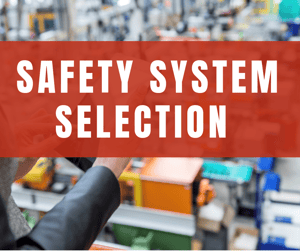-Aug-06-2023-08-51-12-3011-PM.png?width=300&name=ACD%20Template%20(6)-Aug-06-2023-08-51-12-3011-PM.png) As factory floors become increasingly complex and incorporate sophisticated modules, the need for fool-proof safety systems also becomes imperative. Organizations have much to lose from operation of unprotected equipment, with the list starting from workers’ lives and going all the way to hefty reinvestments. Safety-rated controls are therefore an important part of the manufacturing industry, but due to the increasingly complex requirements, System Engineers must take into account certain factors when selecting such equipment.
As factory floors become increasingly complex and incorporate sophisticated modules, the need for fool-proof safety systems also becomes imperative. Organizations have much to lose from operation of unprotected equipment, with the list starting from workers’ lives and going all the way to hefty reinvestments. Safety-rated controls are therefore an important part of the manufacturing industry, but due to the increasingly complex requirements, System Engineers must take into account certain factors when selecting such equipment.
High-demand Architectures
Safety control architectures can be split into two major families, single channel and dual channel. Single Channel 1001 architecture is widely used in lower level systems such as SIL 1, SIL 2, PL a/b/c, etc. The architecture relies on the ingenuity of programmers to detect value faults, memory errors and/or electrical noise problems. The operations are carried out on the same processor which decreases the reliability of the system. Furthermore, there is always an impending risk of electrical influences that can affect the state of gates.
In a nutshell, these systems are affordable and simple in terms of deployment but leave a gap for high diagnostic coverage.
In retrospect, the dual channel 1002 architecture is much more comprehensive, allowing each redundant logic solvers to execute its safety functions. If a faulty condition is detected, the other channel can be used to bring the system back to a normal stage. This gives the system an extra layer of protection, and the reason why this architecture is followed by SIL 3, PL d/e and CAT 3/4 systems.
Evaluating Safety Attributes
Automation and security capabilities of a system are highly dependent on the programming software use. Even though IEC 61131-3 programming standard is used throughout the industry, the configuration of systems is still susceptible to errors.
To mitigate these risks, users can utilize software that have additional functions that help manage memory and eliminate the need for manual separation of standard and safety memory. Commissioning can also be sped through add-on instructions that improve code re-usability, bringing down the chances of errors.
Lastly, access control can be used that would give certain individuals the ability modify code, protecting intellectual property as well as a major productivity disruption.
Maximizing Functionality
Connectivity
You should be asking the following questions when making a choice for connectivity of the HMI, SCADA or control system:
As a point of reference, ethernet systems have a lower cost and allow distributed safety I/O whilst enabling communication with PLCs and HMI systems, at the same time supporting multiple protocols.
Interested in learning more, connect with an ACD expert!
You may also be interested in reading:


